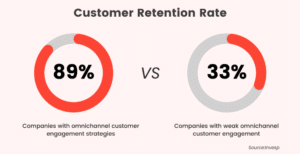Leveraging Omnichannel Shopping in Your Retail Strategy
24/09/2024 | by Lucy Lefroy

Rapid technological advances and changing consumer behaviour are reshaping the retail landscape.
The demand for a seamless customer experience is paramount across all brand touchpoints, whether through a website, mobile app, or brick-and-mortar store.
McKinsey reports that omnichannel customers shop 1.7 times more than shoppers who use a single channel, and they also spend more. This is a clear sign to retailers to prioritise a consistent, integrated experience among all platforms where buyers can start their journey on one channel and immediately move onto another.
In this blog, we will look at the benefits of omnichannel shopping, how to implement it, and why it is so important for today’s marketers.
What is Omnichannel Shopping?
Customers increasingly engage with brands across various channels like in-store, website, social media, emails, apps – looking for the most convenient way to fulfil their needs. Omnichannel shopping is the integration of shopping channels-online and offline-into one, to present a customer with an integrated experience. Effective omnichannel marketing ensures that companies offer a seamlessly integrated experience across these channels, catering to customer preferences and guiding them toward the most efficient solutions. Different levels of interaction exist on different platforms in multichannel shopping; omnichannel makes it seamless across all channels.
For example, it could be a person who’s comparing items on your website, then adds items to her shopping cart via a mobile app, and finally chooses in-store pickup. These are all touch points of the shopping experience that are interconnected with one another.

Why Should Retailers Use an Omnichannel Approach
Enhanced Customer Engagement
Customers who use more than one channel to communicate with your business are far more likely to remain loyal. In a Google study, omnichannel shoppers have a 30% higher lifetime value compared to those using one channel to shop. More touch points mean more opportunities for retailers to engage customers and foster long-term relationships.
Higher Levels of Customer Loyalty
Consistency is the key to loyalty. By leveraging omnichannel shopping, a retailer creates one experience that customers can depend on. This may simply be that a customer has verified stock online before going to a store, or even started their purchase online and completed it in-store. Such fluency and dependability ensure customer loyalty.

Higher Conversion Rates
Omnichannel shopping gives a customer a lot more choice, which can make a world of difference to conversion. Studies have shown that 73% of shoppers are more likely to make a purchase if they can shop on multiple channels. Offering options like buy-online-pick-up-in-store (BOPIS) or curbside pickup helps convert more leads into sales.
Key Benefits of Omnichannel Shopping Platforms
Improved Customer Experience
The modern customer expects a brand to be aware of their preferences and to offer customised experiences. The integration of data from all touch points allows retailers to come up with a personalised experience that strikes a chord with their customers. You get to anticipate omnichannel customers’ needs and offer recommendations of relevant products, and you can actually reach out to them when it really matters.
Data-Driven Insights
The access to customer data provided by omnichannel platforms gives great value in honing marketing strategies to better target audience segments. By using real-time data across disparate channels, retailers can analyse purchase patterns, track customer behaviours, and thus optimise their sales approach.
Sales Growth
Retailers that adapt to omnichannel shopping often experience a spike in sales. In fact, Aberdeen Group reports that companies with the strongest omnichannel strategies enjoy an annual revenue increase of 9.5% year over year, compared to 3.4% for those without. Providing customers with a flexible shopping experience will increase the possibility of conversions and repeat purchases.
Improved Brand Exposure
Practical Steps to an Omnichannel Retail Strategy
- Step 1: Analyse Customer Data
Know your customer’s behaviours and preferences. Use a tool to collate analytics, in-store interactions and engagement to build information-rich customer profiles. The findings will help build the structure to support an omnichannel experience that will meet the needs of your audience.
- Step 2: Choose the Right Platforms
Identify where your customers are most active; this could be a mix of online stores, mobile apps, email and social media channels alongside physical locations. These need to be integrated well to provide your customer the ease of transition from one platform to another.
- Step 3: Integrate Technology
Technology serves as an important differentiator in omnichannel success. Your POS systems, inventory management tools, and customer databases should all be synchronised to provide a unified experience.
- Step 4: Train Your Staff
Staff need to be well-trained for addressing omnichannel interactions. It could be the in-store employees who are processing the online orders, or the customer service teams responding to multiple channel queries. Consistent training will help them feel prepared.
- Step 5: Monitoring for Performance and Further Optimisation
Track key performance indicators such as the rate of conversion, rate of cart abandonment, and customer retention. Use this to continuously improve your omnichannel approach, bringing out the best customer experience.
Evolution of Consumer Behaviour and Why Omnichannel Shopping Fits
Consumer expectations have changed a lot over the last couple of years. Today’s shopper is looking for immediacy, personalisation, and extensive choices of how and where to shop. According to PWC’s Global Consumer Insights Survey, nearly 80% of consumers expect a consistent shopping experience across all touchpoints, which is why an omnichannel strategy fits. By integrating all customer touchpoints, whether they browse online and purchase in-store, or engage with customer support via social media, their experience remains smooth and personalised. This approach caters to their need for flexibility, and builds lasting brand loyalty.
Conclusion
Omnichannel shopping is no longer a passing trend; it’s an intrinsic strategy that every retailer needs to adopt if they want to stay competitive in the changing marketplace.
Integration of online and offline channels by a retailer offers a seamless shopping experience to its customers, which not only raises the level of engagement but also loyalty and sales. Improving customer satisfaction, smoothing out internal operations, or opening up new markets, there’s a secret for long-term growth and prosperity hidden inside an omnichannel approach.
With growing consumer expectations, omnichannel strategies are not options but mandates for investment. With flexibility, personalisation, and convenience topping the charts of customer demands, it substantiates the call on a retailer’s ability to identify them and deliver the same experience across touchpoints.
How Proximity Can Help With Your Omnichannel Strategy
Proximity is a powerful platform designed to help you take full advantage of your omnichannel strategy. Stitching together data from in-store interactions and online behaviours, Proximity’s Retail Super-App gives you actionable insights that will truly enable you to make a very personalised experience at each step of the customer journey.
Here’s how Proximity can support your omnichannel strategy:
- Data Capture: Round up customer data from every touch-point for a comprehensive, unified view of the preference of each of your customers as a way of delivering personalised experiences to the
- Clienteling: With the ability to monitor customers’ behaviour in real time, you can make prudent decisions while enhancing customer interaction-easily and timely adjusting your strategy against the demand of customers
- Mobile POS: Seamlessly integrate with your current point-of-sale system, inventory management software, and marketing software for a cohesive customer experience across all touchpoints
- Personalisation: Use insights and personalised offers to more effectively engage customers
FAQs
What is an omnichannel approach?
The omnichannel approach involves the integration of multiple channels of communication online and offline for the continuous customer experience: website alignments, mobile apps, social media, brick-and-mortar stores, and other platforms to ensure uniformity and coherence in handling customers.
What is the principle of omnichannel?
The very principle of omnichannel means that the customer’s experience will be integrated, hence seamless, across different platforms, by ensuring continuity in branding and messaging, regardless of the medium of interaction-either online or in-store. It simply guarantees frictionless transitions for customers across different platforms, enriched with better experiences and satisfaction.
What do omnichannel customers want?
For omnichannel customers, the transitioning between platforms should be less of a hassle; personalised recommendations and customer support would be expected. In short, they want inventory visibility in real time, shopping options that are flexible such as BOPIS, and for returns and exchanges to be easier. It’s all about convenience and efficiency.
